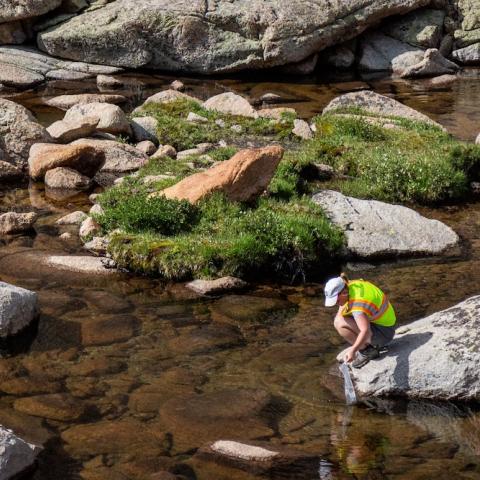As the name implies, Rocky Mountain National Park includes plenty of rocks, but a fall by a hiker in unusually rugged terrain led to a lengthy and challenging rescue earlier this week. By the time the fourteen-hour operation ended, over forty rescuers had helped lower the victim a distance that equalled the height of the tallest buildings in the country.
At about 12:45 p.m. on Monday, June 8, Rocky Mountain National Park’s dispatch center received a call that Rick Grigsby, 62, from Estes Park, had fallen in a steep off- trail area between Arch Rock and The Pool on the lower Fern Lake trail.
Rocky Mountain National Park Search and Rescue (SAR) Team members responded to the area, but since the incident occurred off-trail, it was difficult for the caller—the victim of the accident—to provide any specific landmarks to guide them to his location. Rescuers searched for four hours in a number of areas, and Mr. Grigsby was eventually located at 5:45 p.m. when rangers heard his yells for help.
SAR Team members determined that Mr. Grigsby had been exploring an extremely steep mud and rock slide area when he fell on rocks and suffered a leg injury. The site was described as "hazardous with steep terrain, loose rock, and unstable footing with burned and downed wood from the 2012 Fern Lake Fire."
The landslide in this area had occurred in the spring of 2013, and the terrain posed some special challenges for the rescue. A key element in any "technical rescue" (one which requires the use of ropes, rigging and other specialized equipment and skills) is locating stable anchor points for a lowering or raising operation, but the word "stable" rarely applies to an area where a rock and mud slide has occurred.
As a result, SAR team members had a difficult time finding suitable anchor points in the steep gully. Once that task was completed, Grigsby was initially lowered more than 1,000 feet to a high marshy meadow; a second technical lowering then took place over an additional 800 feet of steep scree (an area of loose, rocky debris.)
Stories about such rescues often mention the distance involved, but most of don't really have a point of reference for those numbers. For a little perspective, the 1,000 feet involved in the first lowering operation is about the height of the Chrysler Building in New York City, the Bank of America Plaza (the tallest in Atlanta) or the U. S. Bank Tower in Los Angeles (the tallest in California.)
The total distance the victim had to be lowered, more than 1,800 feet, was greater than the height of the newly-completed One World Trade Center, and about three times the height of the Space Needle in Seattle. In many respects, the treacherous footing in steep areas of loose rock makes such lengthy evacuations much more difficult than a vertical lowering operation down the face of a sheer cliff.
Once the team reached firmer terrain, Mr. Grigsby was carried down the trail in a wheeled litter; they arrived at the Fern Lake Trailhead at 2:30 a.m. Over 40 Rocky Mountain National Park Search and Rescue Team members were involved in this incident.
A park spokesperson noted that the victim was travelling alone and was fortunate to have cell phone coverage in the area where he fell.



 Support Essential Coverage of Essential Places
Support Essential Coverage of Essential Places







Add comment